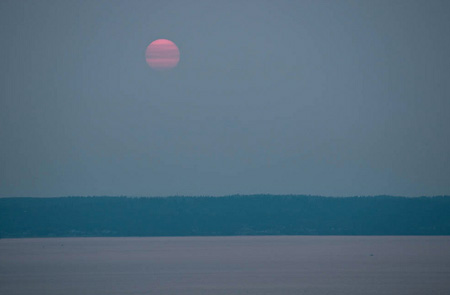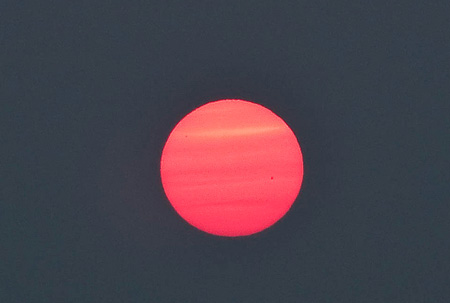We’ve had some pretty amazing sunsets recently and the sun has been beautiful shades of orange.

“My wife noticed how orange the sky was the other day (Thursday, 6 August), so we headed up to Sunset Hill Park to watch the sunset,” a MyBallard reader emails us. “As the sun sank lower, she noticed that she could see a sunspot through her binoculars. And when I processed the photo in Lightroom, I could see another one.”

Click here for a larger image of this photo.
“One is about 11 o’clock, near the left rim, in the bright band. The other is a little below the equator, about 1/3 of the way in from the right rim,” he writes. The photos were taken with a Nikon D300: ISO 200, f/5.6, 200mm, 1/320.
14 thoughts to “Ballardite catches sunspots through camera lens”
Leave a Reply
You must be logged in to post a comment.


Looks like dust on the CCD.
Wow! Nice job! I don't think I've ever seen sunspots like that. Thanks for sharing!
Dust is unlikely. The CCD was recently cleaned, and there have been no other pictures (out of the hundreds I shot this week) in which those two spots appear in that position in the frame. We could see one of the sunspots through my wife's binoculars, and tracked it for a few minutes before we realized what we were seeing.
Catch and release, I hope . . . : )
Just a note to those who might want to also view sunspots that it is normally VERY dangerous (i.e. instant burned retina) to look at the sun through binoculars. A safe and easy way to view the sun's disk is to make a pinhole in a sheet of paper, then hold that paper perpendicular to the sun in front of a second sheet of paper. In effect, this makes a pinhole camera; the further back the second sheet is from the first, the larger the image of the sun's disk.
For those who might also be interested in viewing sunspots, please remember that viewing the sun through binoculars is normally VERY dangerous (i.e. instant burned retina). A safe and easy view to view sunspots is to poke a small round hole (e.g. using a pin) in a sheet of paper, then to hold that paper in front of a second sheet of paper, both oriented perpendicular to the sun. This makes what is in effect a pinhole camera, and projects an image of the sun's disk on the second sheet of paper. The further back the second sheet is held, the larger the disk.
Forgot to add that they are neat photos!
Good photo of what should be sunspots identified as 1092 and 1093 – not dust. But please, never… ever… look at the sun using binoculars or a telescope without the proper solar filters. Even with the smokey sky, you can still damage your eyes!
nice
Amazing
Interesting, I took photos at the same time but have not viewed them on the computer yet. I'll have to check and see if the same spot appears on mine.
How interesting!
Maintaining a healthy relationship over an Vidmate extended period of time requires honest and open communication, compromise, and a willingness for both people to grow together.
While the idea of “love at first sight” https://tutuappx.com/ dominates popular movies and media, building a long-lasting and meaningful relationship usually takes more work than just seeing each other.